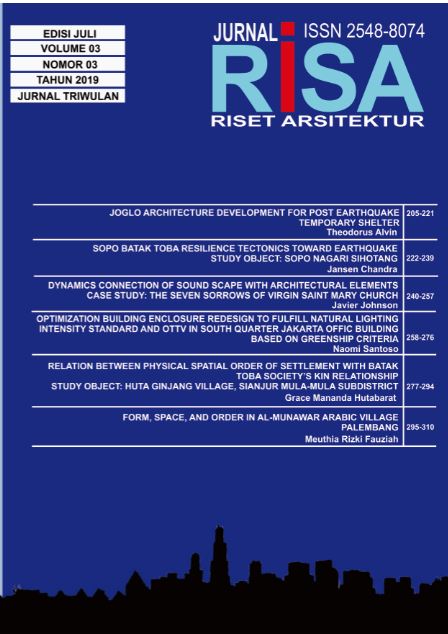RELATION BETWEEN PHYSICAL SPATIAL ORDER OF SETTLEMENT WITH BATAK TOBA SOCIETY’S KIN RELATIONSHIP STUDY OBJECT: HUTA GINJANG VILLAGE, SIANJUR MULA-MULA SUB-DISTRICT
DOI:
https://doi.org/10.26593/risa.v3i03.3336.277-294Abstract
Abstract- Batak Toba tribe is an ethnic group that still holds tradition as an identity that distinguish them from other ethnic groups in Indonesia. Part of the culture that strongly influences society’s daily life is the kinship, as can be seen with the usage of family name and the philosophy of Dalihan na Tolu, which regulates attitudes and behaviors among society. Aside from the kinship, the traditional architecture is also a cultural identity of Batak Toba tribe, ranging from the order of settlements to organization of space in each dwelling.
The research aims to study the physical spatial order of the settlements as a consequence of Batak Toba kinship system, to see the relation between settlement’s physical spatial order with the clan system and the philosophy of Dalihan na Tolu, and lastly to see the effect of modernization in the development of Batak Toba settlements.
Huta Ginjang Village in Sianjur Mula-mula is an indigenous village that still holds Batak Toba tradition and culture. Residents are mostly from the Sagala clan and originated from one ancestor. Each house is inhabited by one nuclear family and the collection of several dwellings in a certain order forms a settlement that still knows the kinship of one another. Huta Ginjang Village consists of eight cluster of settlements that still have relation to each other, forming a small clan group.
Data on the spatial physical order of the settlements in Huta Ginjang Village and the society’s kin relationship are obtained from literature studies, direct observation in the object of study, and interview with the villagers. The obtained data were analyzed qualitatively by using the relation theory in architecture.
The result of the research shows the undeniable relation between physical spatial order of settlement in Huta Ginjang Village with the society’s kin relationship, either on the village, huta, or on the dwelling scale. One of the relation can be seen in the absence of hierarchy in dwelling placement, as the principle of the Dalihan na Tolu has no hierarchy between each of the components. The relation with the kin relationship cannot be seen from each of the building’s typology, because there are no special features that distinguishes each of the kinship groups.
Key Words: relation, physical spatial order, kin relationships, Huta Ginjang Village












